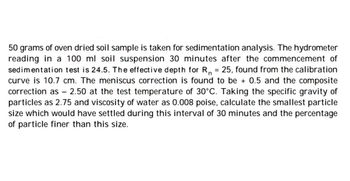
Structural Analysis
6th Edition
ISBN: 9781337630931
Author: KASSIMALI, Aslam.
Publisher: Cengage,
expand_more
expand_more
format_list_bulleted
Concept explainers
Question

Transcribed Image Text:n
50 grams of oven dried soil sample is taken for sedimentation analysis. The hydrometer
reading in a 100 ml soil suspension 30 minutes after the commencement of
sedimentation test is 24.5. The effective depth for R₁ = 25, found from the calibration
curve is 10.7 cm. The meniscus correction is found to be + 0.5 and the composite
correction as - 2.50 at the test temperature of 30°C. Taking the specific gravity of
particles as 2.75 and viscosity of water as 0.008 poise, calculate the smallest particle
size which would have settled during this interval of 30 minutes and the percentage
of particle finer than this size.
Expert Solution
This question has been solved!
Explore an expertly crafted, step-by-step solution for a thorough understanding of key concepts.
Step by stepSolved in 5 steps with 4 images

Knowledge Booster
Learn more about
Need a deep-dive on the concept behind this application? Look no further. Learn more about this topic, civil-engineering and related others by exploring similar questions and additional content below.Similar questions
- Q': A- Classification tests have been performed on a soil sample and the grading curve that shown in (Fig. 1) and Atterberg limits obtained. Classify the soil using the USCS? L.L=32 and P.L=26 100 80 60 40 20 Fig. 1 0.1 1 Particle size (mm) 0.0001 0.001 0.01 10 100 % Finerarrow_forwardA cohesive soil sample is subjected to an unconfined compression test. The sample fails at a pressure of 3850 lb/ft2 [i.e., unconfined compressive strength lb/ft2]. Determine the soil’s cohesion. If an unconfined compression test is performed on the same clayey soil, what axial load can be expected at failure?arrow_forwardIt’s a common observation that hydraulic conductivity of fine sands is greater than that of clean gravels (True or False) Standard Penetration Test (SPT) N-values can be correlated with soil’s unconfined compressive strength (True or False) If a soil sample has a 100% degree of saturation, the sample’s water content also becomes 100% (True or False) In the consolidation theory, the greater the coefficient of consolidation (cv), the faster the consolidation (True or False)arrow_forward
- Classify: A sample of well-graded gravel with sand has 73% fine to coarse sub-angular gravel, 23% fine to coarse sub-angular sand, and 4% fines. The maximum size of the particles is 75 mm. The coefficient of curvature is 2.7, while the uniformity coefficient is 12.4.arrow_forwardIn Triaxial test, which of the following parameters do not need to be recorded the confining pressure specimen diameter changes ) the generated pore pressure the axial force A Triaxial test was performed on a dry, cohesionless soil. If the sample failed vhen the minor principal stress was half of the major principal stress, the soil's angle of internal friction is: O 22.5 19.5 33.3 O 25 A technician obtained a soil void ratio of 1.5. It is okay because it is possible to measure void ratio values above 1. True False |arrow_forwardSr B. ( A Soil Specimen has the following characteristics: % passing No.4 sieve = 85 % passing No.200 sieve = 11 D60 = 2 mm D30=0.35 mm D₁0 = 70 μm D8=2 μm L.L = 36% P.L = 31% 1. Classify the specimen according to the Unified Soil Classification System (USCS). Assign the group name and the group symbol. 2. Determine the soil activity. 3. Determine the soil Liquidity index and consistency index if wc = 26%.arrow_forward
arrow_back_ios
arrow_forward_ios
Recommended textbooks for you

 Structural Analysis (10th Edition)Civil EngineeringISBN:9780134610672Author:Russell C. HibbelerPublisher:PEARSON
Structural Analysis (10th Edition)Civil EngineeringISBN:9780134610672Author:Russell C. HibbelerPublisher:PEARSON Principles of Foundation Engineering (MindTap Cou...Civil EngineeringISBN:9781337705028Author:Braja M. Das, Nagaratnam SivakuganPublisher:Cengage Learning
Principles of Foundation Engineering (MindTap Cou...Civil EngineeringISBN:9781337705028Author:Braja M. Das, Nagaratnam SivakuganPublisher:Cengage Learning Fundamentals of Structural AnalysisCivil EngineeringISBN:9780073398006Author:Kenneth M. Leet Emeritus, Chia-Ming Uang, Joel LanningPublisher:McGraw-Hill Education
Fundamentals of Structural AnalysisCivil EngineeringISBN:9780073398006Author:Kenneth M. Leet Emeritus, Chia-Ming Uang, Joel LanningPublisher:McGraw-Hill Education
 Traffic and Highway EngineeringCivil EngineeringISBN:9781305156241Author:Garber, Nicholas J.Publisher:Cengage Learning
Traffic and Highway EngineeringCivil EngineeringISBN:9781305156241Author:Garber, Nicholas J.Publisher:Cengage Learning


Structural Analysis (10th Edition)
Civil Engineering
ISBN:9780134610672
Author:Russell C. Hibbeler
Publisher:PEARSON

Principles of Foundation Engineering (MindTap Cou...
Civil Engineering
ISBN:9781337705028
Author:Braja M. Das, Nagaratnam Sivakugan
Publisher:Cengage Learning

Fundamentals of Structural Analysis
Civil Engineering
ISBN:9780073398006
Author:Kenneth M. Leet Emeritus, Chia-Ming Uang, Joel Lanning
Publisher:McGraw-Hill Education


Traffic and Highway Engineering
Civil Engineering
ISBN:9781305156241
Author:Garber, Nicholas J.
Publisher:Cengage Learning